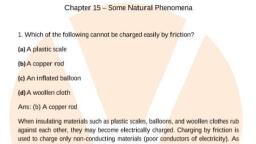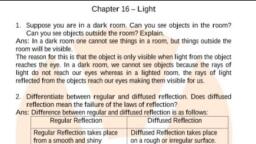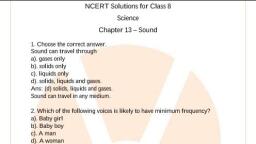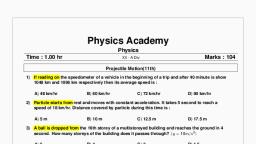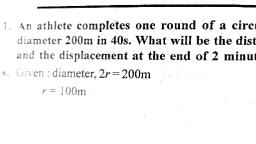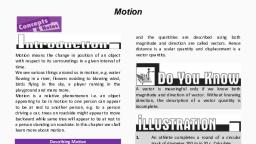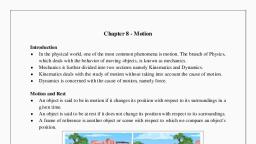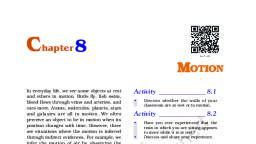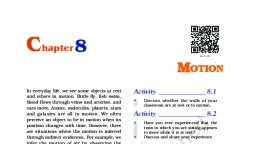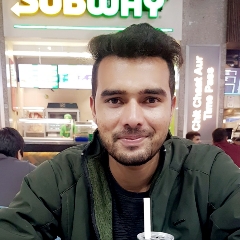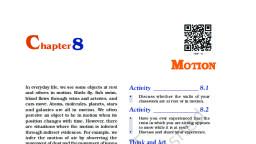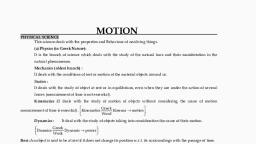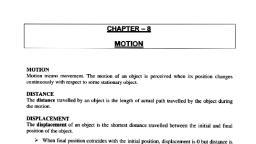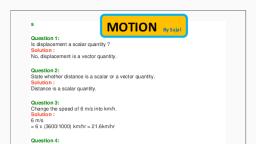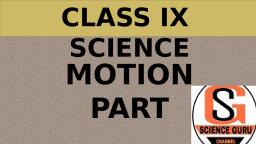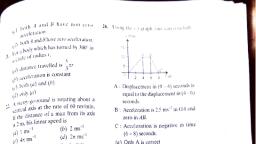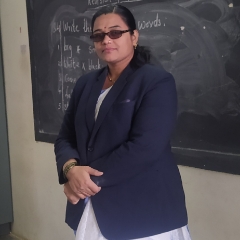Page 1 :
An athlete completes one round of a circular track of diameter 200 m in 40 s. What will be, the distance covered anc! the displacernent af the end of 2 minutes 20 s?, , Sohution 2, Diameter of a circular track, d = 200m, , Rahs of te tack. = $ = 100m, , Circumference = 2ar = 22 (100) = 2002 m, In 40 5, the given athlete covers a distance of 200 m., 20x, , In.1 5, the given athiete covers a distance = =a
Page 2 :
‘The athlete runs for 2 minutes 20s = 140s, , “Total distance covered in 140s = 22°22"'° = 2198m, , ‘The athlete covers one round of the circular track in 40 5, This means that after every 40 s,, the athlete comes back to his original position, Hence, in 140 5 he had completed 3 rourcds of, the circular track and Is taking the fourth round. He takes 3 rounds in 40 x 3 = 120 6. Thus,, after 120 5 his displacement is zero, Then, the net displacement of the athlete is in 20 s only., In this interval of time, he moves at the opposite end of the initial position. Since, displacement is equal to the shortest distance between the initial and final position of the, athlete, displacement of the athtete will be equal to the diameter of the circutar track., , + Displacement of the athlete = 200 m, , Distance covered by the athlete in 2 min 20 s is 2198 m and his displacement is 200 m,, , , , Question 3:, , Joseph jogs from one end A to the other end B of a straight 300 m road in 2 minutes SO, seconds and then turns around and jogs 100 m back to point C in another 1 minute, What are, Joseph's average speeds and velocities in jogging (a) from A to B and (b) from A to C?, , Solution 3:, (a) 1.765 mrs, 1.765 mis (b) 1.739 mis, 0.87 mvs, (a) From end A to end B, , 4 @—__—__-»—__» en, —$§— «1 m ——>, , Distance covered by Joseph while jogging from A to B = 300 m, Time taken to cover that distance = 2 min 50 seconds = 170 5, , . j= Total distance covered, = Total time taken, , Total distance covered = 300 m, , eenrerne oe, , Average speed = a =1.765 1s, , Marae veloChty = i innerval, , Displacement = shortest distance between A and B = 300m, Time interval = 1705, , Average velocity = 29° = 1.765 ms, ‘The average speed and average velocity of Joseph from A to B are the same and equal to, 1.765 mvs,, , (b) From end A to end C, , c, \ @—— -—@-<—-0, We ee, —$§{_— 1.) >» ——
Page 3 :
_ Total distance covered, (overage Spe = sas tiene taken, , Total distance covered = Distance from A to B + Distance from B to C, , = WO + 100= 400m, , Total time taken = Time taken to travel from A to B + Time taken to travel from 8 to, C=170+60=230s, , =f., Average speed 2 1739 ns, , Average velocaty = PMT, , Displacement from A to C = AC « AB = BC 300 ~ 100 « 200m, Time interval = time taken to travel from A to B + time taken to travel from B to C, = 170+ 60= 230s, , Average velocity = 20 = 0.87 ms, The average speed of Joseph from A to C is 1.739 vs and his average velocity ts 0.87 mvs., , , , Question 4, , Abdul, vehile driving to school, computes the average speed for his trip to be 20 km tr*. On, ‘his return trip along the sare route, there is less traffic and the average speed ts 40 km ty*., What is the average speed for Abdul's trip?, , Solution 4, ‘Case |: While driving to school, Average speed of Abdul's trip = 20 knvh, Total distance, Average S000 = time ken, Total distance = Distance travelled to reach school = d, Let total time taken = ty, , 2004, 4, , d, t-5, , Case Hh: While returning from school, Total distance = Distance travelled while returning from school = d, Now, total time taken = ty, , ribs, \, =<., Average speed for Abdul's trip = Total distance covered in the trip, , Total time taker
Page 4 :
Where,, Total distance covered in the wip =d +d = 2d, Total time taken, t = Time taken to go to school + Time taken to return to school = t, + ty, , . =, . Average speed tet, , From equations (i) and (ti,, ‘Average speed = gna tr 2 m87ms, 20°40 40, , Hence th average sea for Ab’ ip 26.67 ms, , , , Question 5:, A motorboat starting from rest on a lake accelerates in a straight line at a constant rate of 3.0, ms* for 8.0 5, How far does the boat travel during this time?, , Solution 5:, , Initial velocity, u = 0 (since the motor boat is initially at rest), Acceleration of the motorboat, a = 3 rvs*, , Time taken, t= 85, , According to the second equation of motion:, , s=ute a!, Distance covered by the motorboat, s, , Hence, the boat travels a distance of 96 m., , , , Question 6, , A driver of a car travelling at $2 km ty* applies the brakes and accelerates uniformly in the, opposite direction. The car stops in 5 5. Another driver going at 3 km h"' in another car, applies his brakes slowly and stops in 10 s, On the same graph paper, plot the speed versus, time graphs for the two cars. Which of the two cars travelled farther after the brakes were, applied?, , Solution 6:, , Case A:, , Initial speed of the car, un = 52 knvh = 14.4 mis, , Time taken to stop the car, ty = 5s, , Final speed of the car becomes zero after 5 s of application of brakes., Case 8, , Initial speed of the car, up = 3 km/h = 0,833 m/s = 0,83 mis, , Time taken to stop the car, t: = 10s, , Final speed of the car becomes zero after 10 s of application of brakes., Plot of the two cars on a speed-time gruph is shown in the following figure:
Page 5 :
123 4 Se 7 8 9 Wo, Tew) —>, Distance covered by each car is equal to the area under the speed-time graph., Distance covered in case A,, , 5 3 <OP OR = x14 4x5=36m, Distance covered in case B,, $=} *08x0Q=5«083«10=4.15m, , Area of AKOPR > Area of AOSQ, Thus, the distance covered in case A is greater than the distance covered in case B. Hence,, , the car travelling with a speed of 52 km/h travels farther after brakes were applied., , Question 7, Fig shows the distance-time graph of three objects A, B and C. Study the graph and answer, , the following questions:, , , , , o4 be 12 te, Tue thou} >, (a) Which of the three is travelling the fastest?, (b) Are all three ever at the same point on the road?, (c) How far has C travelled when B passes A?, (d)How far has B travelled by the time it passes C?, , Solution 7
